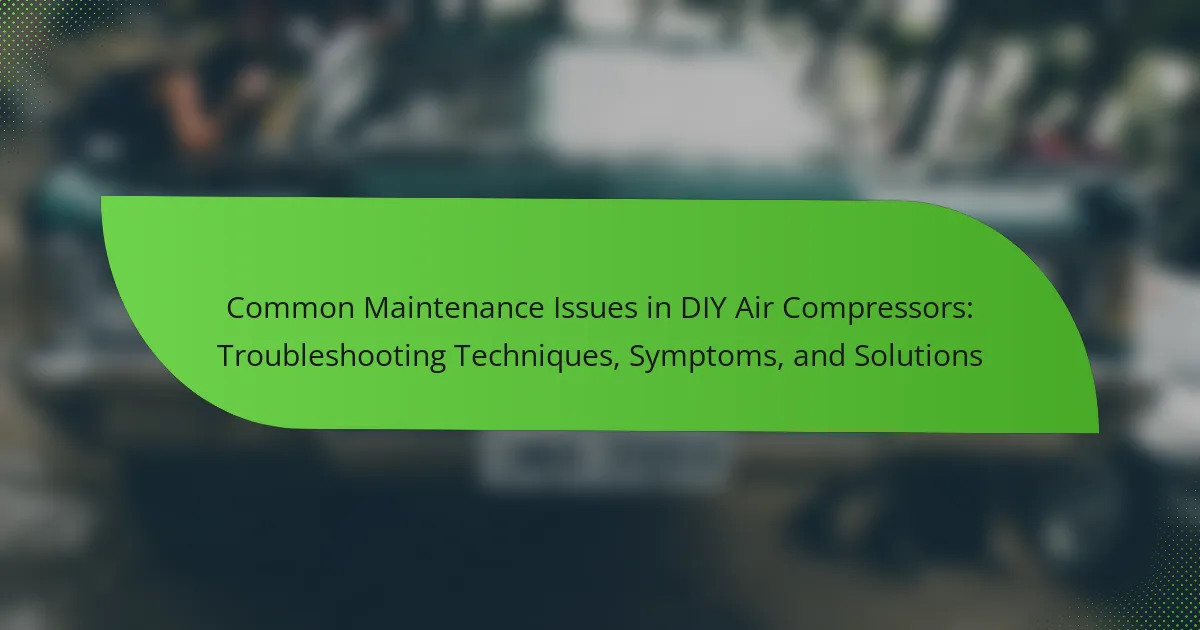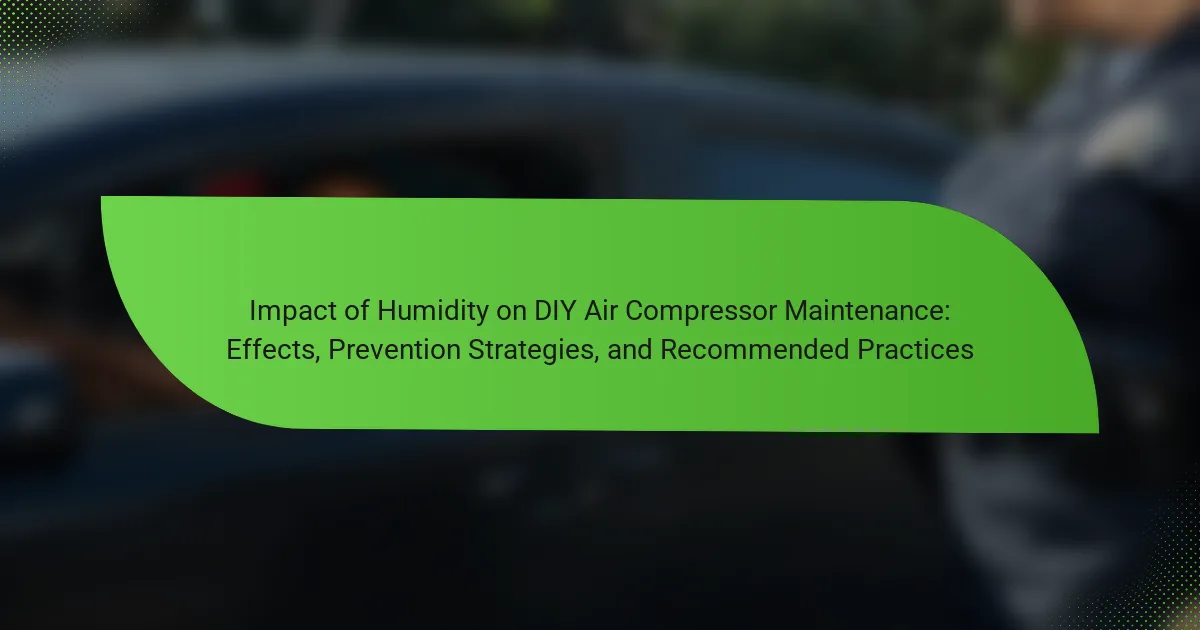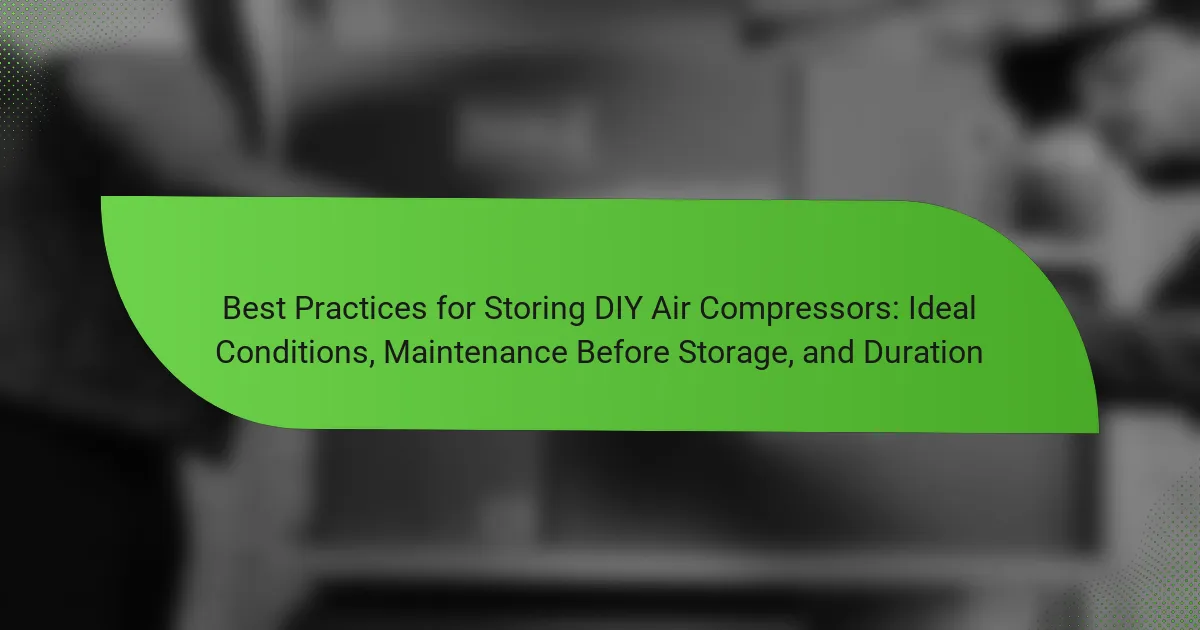Seasonal maintenance for DIY air compressors is essential for ensuring optimal performance and longevity. Key maintenance tasks include checking oil levels, inspecting hoses, draining moisture from the tank, and replacing air filters. Common mistakes to avoid are neglecting oil changes, failing to clean filters, and not addressing moisture buildup, which can lead to rust and decreased efficiency. Proper preparation steps, such as reviewing the manufacturer’s manual and testing safety valves, are crucial for maintaining air compressor reliability. These practices collectively enhance the air compressor’s functionality and safety throughout the seasons.
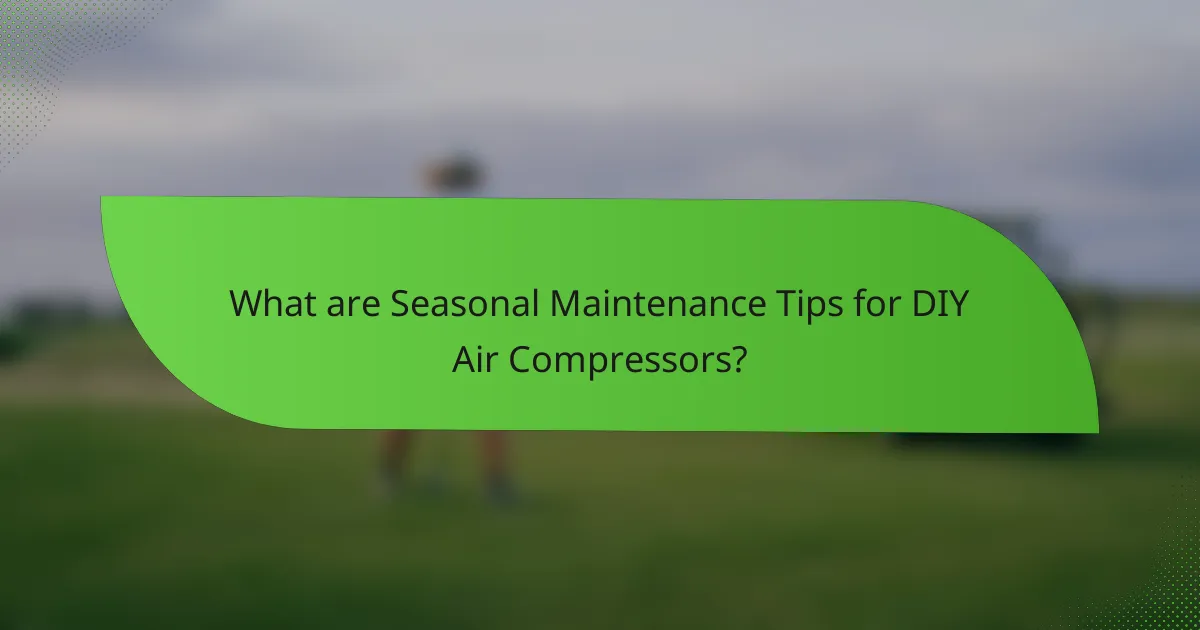
What are Seasonal Maintenance Tips for DIY Air Compressors?
Seasonal maintenance tips for DIY air compressors include checking the oil level, inspecting hoses, and draining moisture from the tank. Regularly change the oil to ensure optimal performance. Inspecting hoses for wear prevents leaks and maintains efficiency. Draining moisture from the tank prevents rust and prolongs the compressor’s lifespan. Additionally, clean or replace air filters to improve airflow. Test safety valves to ensure they operate correctly. Finally, store the compressor in a dry, temperature-controlled environment to protect it from extreme weather conditions. These practices enhance the reliability and longevity of air compressors.
Why is seasonal maintenance important for DIY air compressors?
Seasonal maintenance is important for DIY air compressors to ensure optimal performance and longevity. Regular maintenance helps prevent breakdowns and costly repairs. It also enhances safety during operation. According to the manufacturers, neglecting maintenance can lead to reduced efficiency and increased energy consumption. Seasonal checks can identify wear and tear before they become serious issues. Proper maintenance includes checking oil levels, replacing filters, and inspecting hoses. These actions help maintain the compressor’s operating condition and extend its lifespan.
What potential problems can arise from neglecting maintenance?
Neglecting maintenance can lead to significant operational issues in air compressors. These issues include decreased efficiency and increased energy consumption. Over time, lack of maintenance can cause wear and tear on components. This wear may result in costly repairs or replacements. Additionally, neglected maintenance can lead to safety hazards. For example, leaks in the system can pose risks of fire or explosion. Regular maintenance ensures optimal performance and extends the lifespan of the equipment. Statistics show that properly maintained equipment can operate up to 20% more efficiently.
How does seasonal maintenance extend the lifespan of an air compressor?
Seasonal maintenance extends the lifespan of an air compressor by ensuring optimal performance and preventing damage. Regularly checking and replacing filters maintains airflow efficiency. Lubricating moving parts reduces friction and wear. Inspecting hoses and connections prevents leaks and pressure loss. Cleaning the compressor prevents dust buildup that can cause overheating. Monitoring and adjusting pressure settings ensures the compressor operates within safe limits. These practices can significantly reduce the risk of breakdowns, leading to a longer operational life. Studies show that regular maintenance can extend equipment lifespan by up to 30%.
What are the key components to check during seasonal maintenance?
Key components to check during seasonal maintenance include the air filter, oil level, and hoses. The air filter should be cleaned or replaced to ensure optimal airflow. Checking the oil level is crucial for proper lubrication of the compressor. Hoses must be inspected for cracks or leaks that can affect performance. Additionally, the pressure switch and safety valve should be tested for functionality. Regular maintenance of these components can extend the lifespan of the air compressor.
Which filters need to be cleaned or replaced?
The filters that need to be cleaned or replaced are the air intake filter and the oil filter. The air intake filter prevents dust and debris from entering the compressor. A clogged air filter can reduce efficiency and increase wear on the motor. The oil filter removes contaminants from the oil circulating in the compressor. A dirty oil filter can lead to poor lubrication and potential damage to internal components. Regular maintenance of these filters is crucial for optimal performance. Cleaning or replacing them as per the manufacturer’s recommendations ensures longevity and reliability of the air compressor.
How do you inspect the oil levels and quality?
To inspect oil levels and quality, check the oil dipstick or sight glass. Remove the dipstick, wipe it clean, and reinsert it. The oil level should be within the marked range. If low, add the recommended oil type. Assess the oil’s color and consistency. Clean, fresh oil is typically amber. Dark or gritty oil indicates contamination. If the oil appears milky, it may contain water. Regular inspection ensures optimal compressor performance and longevity.
What tools and materials are needed for seasonal maintenance?
Essential tools and materials for seasonal maintenance include wrenches, screwdrivers, and air compressor oil. A pressure gauge ensures proper air levels during maintenance. Cleaning supplies like rags and brushes help maintain cleanliness. Replacement filters are necessary for optimal performance. Safety gear, including gloves and goggles, is crucial for protection. A multimeter can diagnose electrical issues effectively. These tools and materials are fundamental for maintaining air compressors efficiently.
Which essential tools should be part of your maintenance kit?
Essential tools for a maintenance kit include a wrench set, screwdrivers, and pliers. A wrench set is necessary for tightening and loosening bolts and nuts. Screwdrivers are essential for adjusting screws on various components. Pliers assist in gripping and bending tasks. Additionally, a tire pressure gauge is crucial for checking air pressure in tires. An air filter wrench helps in replacing air filters efficiently. A multimeter is useful for electrical diagnostics. Lastly, a cleaning brush is important for maintaining cleanliness of parts. These tools collectively ensure effective maintenance of air compressors.
What types of lubricants are recommended for air compressors?
Air compressors typically use synthetic or mineral oil lubricants. Synthetic oils offer superior lubrication and temperature stability. They help reduce wear and extend the lifespan of the compressor. Mineral oils are also effective but may require more frequent changes. It’s essential to follow the manufacturer’s recommendations for lubricant type. Using the wrong lubricant can lead to decreased performance. Regular maintenance ensures optimal functioning of the air compressor.
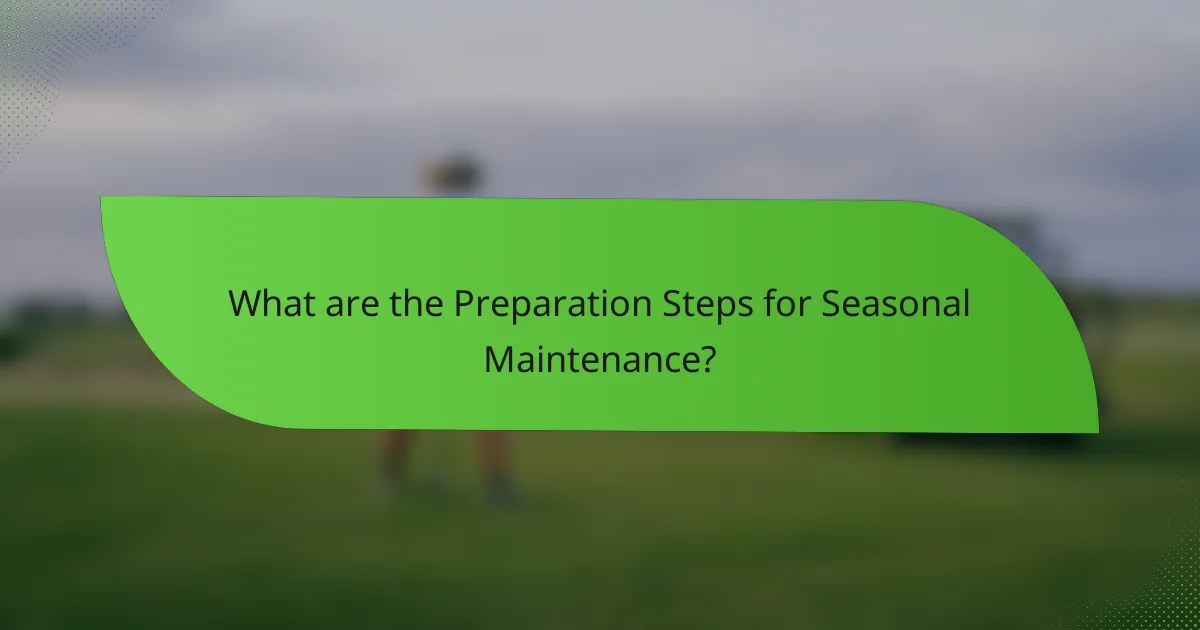
What are the Preparation Steps for Seasonal Maintenance?
The preparation steps for seasonal maintenance include inspecting the air compressor, checking the oil level, and replacing the air filter. Inspecting the air compressor ensures there are no leaks or damage. Checking the oil level is crucial for optimal performance. Replacing the air filter improves air quality and efficiency. Additionally, draining the water from the tank prevents rust and corrosion. Testing the safety valve is essential for proper operation. Cleaning the exterior of the compressor helps maintain its condition. Finally, reviewing the manufacturer’s manual provides specific maintenance guidelines. These steps ensure the air compressor operates efficiently throughout the season.
How do you prepare your workspace for maintenance?
To prepare your workspace for maintenance, start by clearing the area of any clutter. This ensures a safe and efficient working environment. Next, gather all necessary tools and supplies, such as wrenches, oil, and cleaning materials. Organizing these items reduces time spent searching for them during maintenance.
Ensure proper lighting in the workspace to enhance visibility. Adequate lighting helps in identifying issues and performing tasks accurately. Additionally, check for any hazards, such as loose wires or spills, and address them immediately. A safe workspace minimizes the risk of accidents.
Finally, review your maintenance checklist to ensure you have all steps covered. This preparation sets the stage for effective and thorough maintenance of your DIY air compressor.
What safety precautions should be taken before starting maintenance?
Before starting maintenance on air compressors, ensure you wear appropriate personal protective equipment (PPE). This includes safety goggles, gloves, and ear protection. Disconnect the power source to prevent accidental startup. Release any built-up pressure in the tank to avoid explosions. Inspect the compressor for leaks or damage before beginning work. Familiarize yourself with the manufacturer’s manual for specific safety instructions. Keep the work area clean and free of obstacles to prevent accidents. Following these precautions reduces the risk of injury and ensures a safe maintenance process.
How do you ensure the air compressor is properly powered down?
To ensure the air compressor is properly powered down, first switch off the power button. Then, disconnect the power cord from the electrical outlet. Next, release any remaining air pressure by opening the drain valve. This step prevents moisture buildup inside the tank. Afterward, inspect the compressor for any leaks or damage. Finally, store the compressor in a dry, safe location to protect it from environmental factors. These steps help maintain the compressor’s longevity and efficiency.
What specific steps should be followed for effective maintenance?
Effective maintenance of air compressors involves several specific steps. First, regularly check and change the oil according to the manufacturer’s guidelines. This ensures proper lubrication and prevents engine wear. Next, inspect and clean the air filter to maintain optimal airflow. A clogged filter reduces efficiency and can cause overheating. Additionally, drain the moisture from the tank to prevent rust and corrosion. This should be done after each use or as recommended.
Next, examine the belts and hoses for wear and replace them if necessary. Worn components can lead to breakdowns. It’s also essential to check the pressure settings and adjust them according to the task requirements. Lastly, perform a thorough inspection of all electrical connections and components to ensure safety and functionality. Following these steps will enhance the performance and longevity of the air compressor.
How do you clean the air intake filter effectively?
To clean the air intake filter effectively, first remove the filter from the air compressor. Use a soft brush or compressed air to remove dust and debris. Rinse the filter with warm, soapy water for deeper cleaning. Allow the filter to dry completely before reinstalling it. Regular cleaning maintains optimal airflow and compressor efficiency. Neglecting this maintenance can lead to reduced performance and increased energy consumption.
What are the steps to drain the moisture from the tank?
To drain the moisture from the tank, first, turn off the air compressor and unplug it. Next, locate the drain valve at the bottom of the tank. Open the drain valve slowly to release the accumulated moisture. Allow the water to flow out completely until no more moisture is present. Close the drain valve securely after draining. Finally, ensure the tank is empty before restarting the compressor. Regularly draining moisture helps prevent rust and extends the compressor’s lifespan.
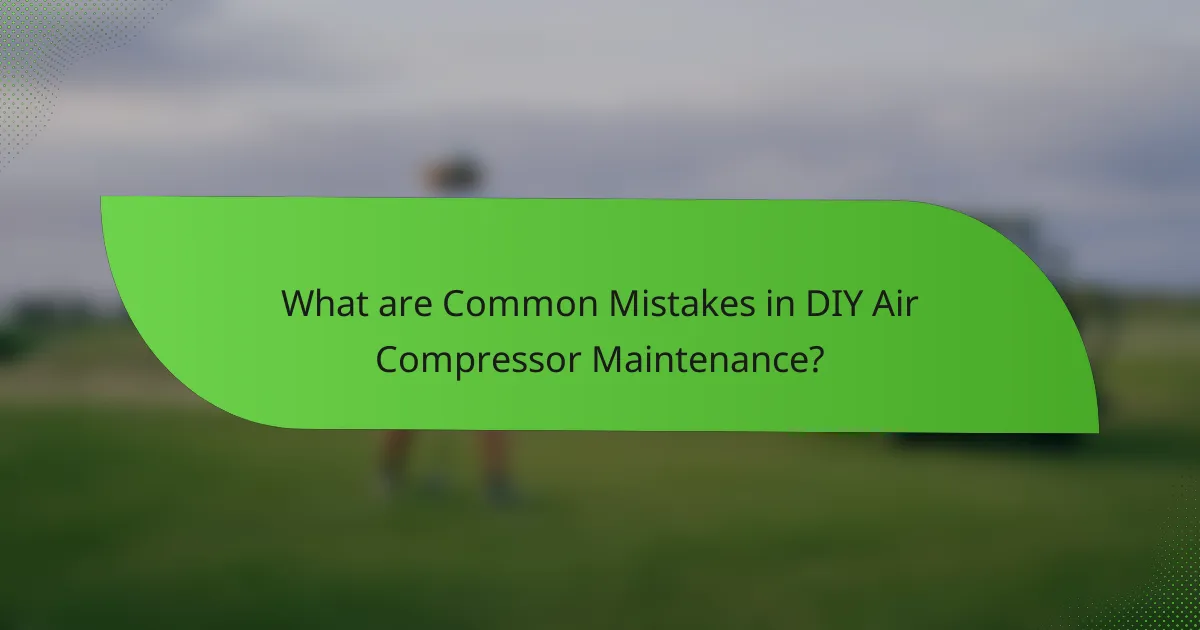
What are Common Mistakes in DIY Air Compressor Maintenance?
Common mistakes in DIY air compressor maintenance include neglecting regular oil changes. Oil should be changed according to the manufacturer’s schedule. Failing to clean or replace air filters is another mistake. Dirty filters can reduce efficiency and lead to damage. Not draining the moisture from the tank is also common. Moisture can cause rust and corrosion inside the tank. Overlooking belt tension can lead to premature wear. A loose or worn belt can affect performance. Lastly, ignoring safety precautions can result in accidents. Always follow safety guidelines during maintenance tasks.
What are the most frequent errors made during seasonal maintenance?
The most frequent errors made during seasonal maintenance include neglecting to check oil levels and not replacing worn parts. Many users forget to inspect air filters, leading to reduced efficiency. Failing to drain moisture from the tank can cause rust and damage. Additionally, improper storage can lead to freezing or damage during off-seasons. Skipping lubrication of moving parts can result in increased wear. Not reviewing the user manual for specific maintenance guidelines is also common. Each of these errors can significantly affect the performance and lifespan of air compressors.
How can improper cleaning affect the performance of the air compressor?
Improper cleaning can significantly hinder the performance of an air compressor. Dust and debris accumulation can obstruct airflow, leading to overheating. When airflow is restricted, the compressor has to work harder, which can decrease its efficiency. Clogged filters can also trap contaminants, reducing air quality and increasing wear on internal components. Regular cleaning is essential to maintain optimal performance and prolong the lifespan of the compressor. Studies indicate that neglecting maintenance can reduce an air compressor’s efficiency by up to 30%.
What risks are associated with using the wrong lubricants?
Using the wrong lubricants can lead to significant risks for air compressors. These risks include damage to internal components. Incorrect lubricants can cause excessive wear and tear. They may also lead to overheating during operation. Incompatibility with seals can result in leaks. This can compromise the compressor’s efficiency. Additionally, improper lubrication can void warranties. Regular maintenance requires using the manufacturer’s recommended lubricant. Following these guidelines ensures optimal performance and longevity.
How can you avoid these common mistakes?
To avoid common mistakes in seasonal maintenance for DIY air compressors, follow a structured checklist. First, ensure the compressor is unplugged before any maintenance. This prevents accidental startups. Next, check and replace the air filter regularly. A clean filter enhances airflow and performance. Inspect hoses and connections for wear or leaks. Damaged hoses can lead to inefficiency and safety hazards.
Additionally, drain the moisture from the tank after each use. This prevents rust and corrosion. Lubricate moving parts as per the manufacturer’s guidelines. Proper lubrication reduces wear and extends compressor life. Lastly, review the user manual for specific maintenance recommendations. Adhering to these practices minimizes the risk of operational issues and enhances the longevity of the equipment.
What best practices should be followed during maintenance?
Regular maintenance of air compressors enhances performance and longevity. Inspect the compressor for leaks and ensure all connections are tight. Change the oil as recommended by the manufacturer to keep the motor lubricated. Clean or replace air filters to maintain airflow efficiency. Drain the moisture from the tank to prevent rust and corrosion. Check the belts and hoses for wear and replace them if necessary. Test the safety valves to ensure they function correctly. Following these practices can reduce breakdowns and extend the lifespan of the compressor.
How can checklists help prevent maintenance oversights?
Checklists help prevent maintenance oversights by providing a systematic approach to tasks. They ensure all necessary steps are completed during maintenance. Each item on a checklist serves as a reminder, reducing the likelihood of forgetting critical actions. Research shows that using checklists can improve compliance with safety protocols by up to 90%. This structured method allows for tracking progress and accountability. By visually confirming completed tasks, checklists minimize human error in maintenance processes. Overall, they enhance efficiency and reliability in maintaining air compressors.
What are the best tips for maintaining your DIY air compressor year-round?
Regularly check the oil level in your DIY air compressor. Maintaining the correct oil level ensures optimal performance. Change the oil as recommended by the manufacturer. This typically occurs every 3 to 6 months. Clean or replace the air filter regularly. A clean filter prevents dust and debris from entering the compressor. Drain the moisture from the tank after each use. This helps prevent rust and corrosion. Inspect the hoses and connections for any signs of wear. Damaged hoses can lead to air leaks and reduced efficiency. Store the compressor in a dry, temperature-controlled environment. This protects it from extreme weather conditions. Lastly, refer to the manufacturer’s manual for specific maintenance guidelines. Following these tips will extend the lifespan of your DIY air compressor.
The main entity of this article is DIY air compressors. The article provides essential seasonal maintenance tips to enhance the performance and longevity of air compressors, including checking oil levels, inspecting hoses, replacing air filters, and draining moisture from the tank. It emphasizes the importance of regular maintenance to prevent operational issues and safety hazards, while also outlining common mistakes to avoid. Additionally, the article presents preparation steps for effective maintenance and highlights best practices for year-round care, ensuring optimal functionality and efficiency of air compressors.
